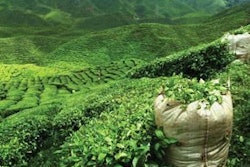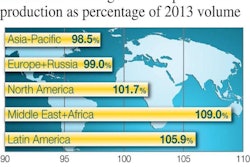In my experience, as a field nutritionist, the two most useful pieces of advice when it comes to feed management of breeding sows are rather contradictory: try to keep gestating sows from overeating versus convince lactating sows to eat as much as possible. Below, I will explain this in more detail.
Do not overfeed gestating sows
In most farms I have visited, gestating sows invariably receive more feed than they actually need. There are of course many reasons (or excuses) for this practice, but the most interesting is the widespread notion that a more "robust" sow will produce heavier piglets at birth. This is as far from truth as it can be, with the exception of sows that start their pregnancy in a really emaciated state. Most "normal" sows can and should remain on the lean -- but again, not emaciated -- side without any loss in breeding performance. In fact, a lean sow will give birth easier, and she will experience higher feed intake during lactation leading to heavier weaning weights and less days to estrus. All these have been proven again and again in controlled university studies.
Under most commercial conditions, and assuming a typical feed composition, gestating sows should receive about 2.5 kg feed per day. This might seem reasonable to most, but there is a school of thought in certain parts of the world where gestating sows receive regularly 3 to 4 kg feed per day throughout gestation. In a 1 to 5 body score scale, sows should be on average on the 3.5 level, and at times where money are lost in the farm, they could be reduced temporarily a bit down to a body score of 3, but never below this point to ensure productivity, health and longevity.
Keep feed fresh for lactating sows
Walking through a typical farrowing barn, several hours after feeding hours, one can always find several if not many feeders still full or half-full of feed, often fouled with water and starting to ferment. Quite often, when the next feeding time comes, the worker is forced to clean the feeder before adding new feed as the sow refuses to eat the stale or fouled feed. In a barn housing 100 sows in lactation, let’s assume there are five such feeders that need cleaning at each feeding, giving 10 feeders per day. If each feeder contains at minimum 1 kg feed (most likely more), the wastage is 10 kg per day, or three to four metric tonnes of feed per year. As lactation feed is not free, there is no good reason for such obvious wastage.
So, what can be done? In small farms, feed allowance should be tied to sow condition, health and size of litter. In other words, the worker and manager should spend a bit of extra time to assess the needs of each individual sow and try to feed her according to her appetite. In large farms, where this is more difficult, it would be best to increase the number of feedings per day (say, from two to three), reducing thus the amount of feed delivered per feeding. This will eliminate the problem of having to ingest a large amount of feed in a short period of time, especially troubling during the first couple weeks post-weaning when appetite and physical stomach capacity are still increasing to cope with the increased metabolic demand for nutrients.

















